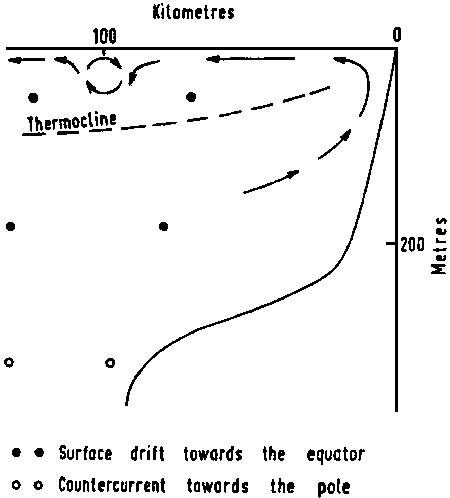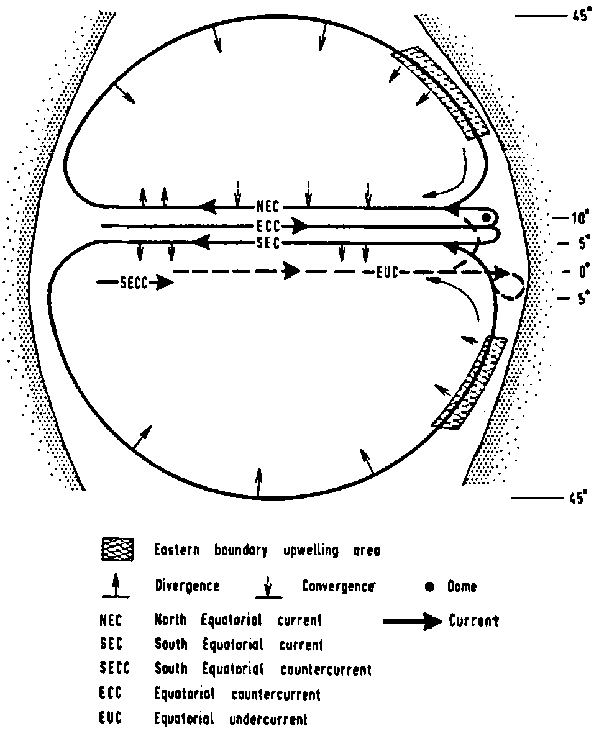In each ocean there are two subtropical anticyclones, one north and one south of the equator. In each, the western boundary current is swift, narrow and intense (up to 4 knots in the northern hemisphere) and the eastern boundary current is broad and slow (about ½ knot) and it tends to be somewhat reduced in salinity because it originates in rainy areas. There is upwelling on the eastern boundaries where the winds tend to blow parallel to the coast towards the equator (Wooster and Reid, 1963). Our first generalization is that upwelling is found in the eastern boundary currents of the subtropical anticyclones (Hutchinson, 1950). Except in the special case of the Somali Current, the western currents are too stable to allow upwelling to take place on the scale found in the eastern currents. In higher latitudes where the circulation is cyclonic and when the wind blows parallel to the coast, it intensifies the cyclonic circulation and makes upwelling unlikely. The second generalization, justified in section 3, is that the biological effectiveness of upwelling is confined to the tropics and subtropics. Upwelling areas tend to lie off desert country and the coastal climate is at times foggy and at times windy.
As the water is blown offshore at an angle to the coast it is moved towards the equator. At about 100 km offshore there is often a convergence where the water sinks and, a little further offshore, a divergence, generating a secondary source of upwelling above the thermocline (Hart and Currie, 1960). There are often large swirls in fixed positions, between local upwelling systems (Reid, Hoden and Wyllie, 1958). The current flowing towards the equator is compensated by a countercurrent below about 200 m flowing towards the pole (Gunther, 1936; Reid, Hoden and Wyllie, 1958; Hart and Currie, 1960). Further, there may be narrow surface countercurrents generated inshore during the period of upwelling (Reid, Hoden and Wyllie, 1958; Wyrtki, 1963). The depth of the whole upwelling system is shallow and its offshore boundary is imprecise.
Figure 1 is a diagram of an ideal vertical section through an upwelling area (adapted from Hart and Currie, 1960 and Bang, in press). Above 200 m the water moves towards the equator and the upwelling system lies within this zone; below it the countercurrent moves towards the pole. The coastal upwelling is bounded between 50-100 km offshore by a cell of convergence and divergence. This is the region which Sverdrup (1938) put his dynamic boundary. Inshore of this boundary there is a region of slow mixing of old and new upwelled waters, and offshore of it there is a region of divergence, a secondary form of upwelling. The "roller bearing" of convergence and divergence (Hart and Currie, 1960) is also an agent of offshore transport. The secondary upwelling offshore of this boundary is associated with the wind stress alone, and is generated by the vorticity of the wind stress. The divergences along the equator and elsewhere are created by the same agency (Hidaka, 1958). More recently Yoshida (1967) has attempted to unify the two phenomena, secondary upwelling and coastal upwelling, in one theoretical frame. There tend to be divergences along the poleward boundary of the subtropical anticyclones, at the western ends of the equatorial currents and along the equatorial boundary of the southern anticyclones; similarly there are convergences along the eastern equatorial currents, particularly in summer along the equatorial boundary of the northern anticyclone (Hidaka and Ogawa, 1958). But there are also upwelling areas where the equatorial currents are formed; the Costa Rica Dome is the most well known, at the root of the North Equatorial Current in the North Pacific, but there are analogous phenomena in the East Atlantic and East Indian Oceans.
Figure 1. A diagrammatic vertical section of an upwelling area. The full line represents the up - welling and offshore drift to the "roller bearing" of convergence and divergence at about 100 km. Because the upwelling system drifts towards the equator, the upwelled water moves outwards at a slight angle to the coast.

Figure 2 is a diagram of the upwelling systems in an ideal ocean, based on observations in the Pacific showing the coastal upwellings in the eastern boundary currents, the divergences and convergences in the equatorial current system and the eastern dome. Also shown are the divergences on the poleward boundaries and offshore of the coastal upwellings. Between the Equatorial Countercurrent and the North Equatorial Current there is a zone of convergence (Cromwell, 1958; Hidaka and Ogawa, 1958 and Wyrtki, 1966). The system is not centered precisely on the equator, but with some seasonal variation, is offset somewhat to the north, so that the Equatorial Countercurrent occurs between 5° and 10°N. The Cromwell Undercurrent lies precisely at the equator and above it are found the divergences in the South Equatorial Current; it is possible that the biological effects of divergence are enhanced by upwelling above the Undercurrent.
Figure 2. Diagram of the distribution of upwelling in an eastern boundary current

Figure 3 is a diagram of the seasonal cycle of upwelling in an eastern boundary current and in the equatorial system. It is based partly on Wooster and Reid's (1963) estimates of Ekman transport normal to the coast. It shows the movement towards the pole of the coastal upwelling systems from spring to autumn as the subtropical high intensifies, and the strengthening of divergence along the equator in winter and spring. The diagram does not show that events in the southern hemisphere are bigger and more persistent, which they are. This may be because stronger winds originate in the Southern Ocean, or because the coastlines have the best shape for the seasonal distribution of the direction of the trade winds. The distribution of divergences and convergences is taken from Hidaka and Ogawa's (1958) charts, an example of which for the Pacific is given in Figure 12.
There are wind driven upwellings and geostrophic upwellings, both in coastal areas and in oceanic areas. Coastal upwelling is generated by winds blowing parallel to the shore towards the equator, as in the major upwellings, or is generated geostrophically by the tilt of a current, as in the Somali Current (Stommel and Wooster, 1965). Some areas may include both wind-generated upwellings and geostrophic upwellings, as for example, the Malabar Coast (Darbyshire, 1967). There is a specialized form of upwelling off Cabo Frio in Brazil where warm salty water offshore sinks and is replaced inshore by cooler less salty water and this process is assisted by northeast winds (Emilsson, 1961). Oceanic upwelling includes both the divergences due to the vorticity of the wind stress, all around the subtropical anticyclones, and the geostrophic upwellings within the equatorial system itself, as for example above the Undercurrent and in the domes.